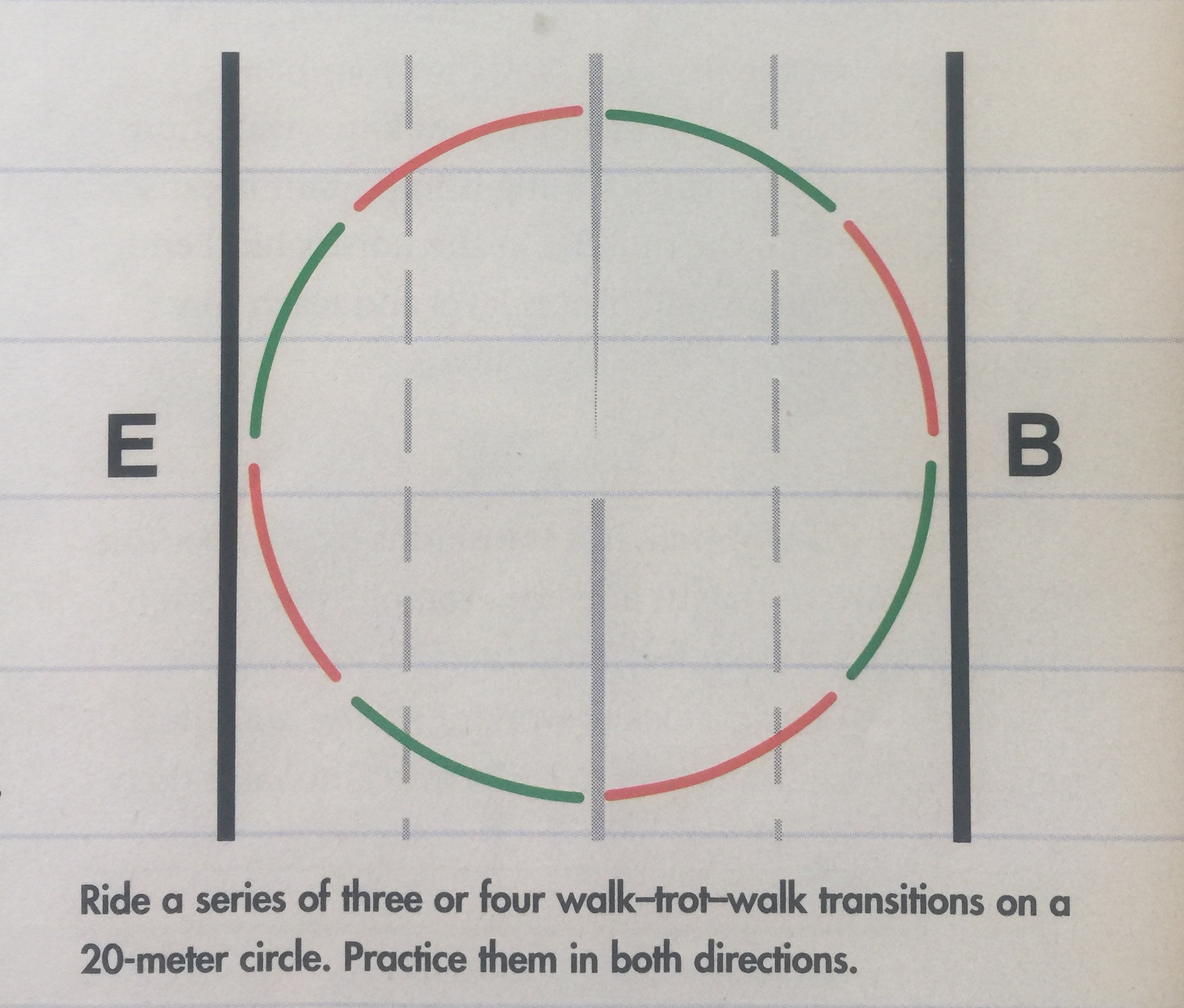Exercise: Ride a series of three to four walk-trot-walk transitions on a 20-meter circle.
Level: Training Level and above.

Benefits
- Riding a series of walk-trot-walk transitions is a great exercise to strengthen the horse and develop his collection and suppleness. Transitions are the basis for strengthening the horse’s hind end, for softening the neck and jowl area and for total body conditioning, which prepares him for higher level movements. When ridden correctly from the back of the horse to the front, transitions put the horse back onto his hocks, which strengthens his hind end and makes him more supple throughout his back.
- Working on three or four transitions in a row will get your horse listening to your seat and leg. When he starts to pay more attention to you, you ride more accurately and with more precision.
- The horse becomes more supple and gains confidence, because he knows you’re there with your seat, leg and hand. He is more relaxed and is better able to understand what you want.
How To Do It
- Start at walk on a 20-meter circle. Ride an upward transition to trot by driving with your seat and legs into your giving hands. Be sure not to give too much (loose reins) or you will throw away the contact. Just try to soften the contact and drive the energy forward into your hands from behind, letting the horse balance himself.
- Ride a downward transition from trot to walk by driving the horse into a resisting (not pulling) hand. This will increase impulsion and shorten his stride. Drive the horse forward during the downward transition the same way as you do going upward. The resistance from the hand in combination with the forward drive from your seat and leg will tell him to come down to a walk. (You will see him raise his neck as he shifts his weight back onto his hocks.) How much you resist with your hands dictates how much forward motion you’ll have and how quickly you’ll get to the walk. You can do the transition over one or two strides, for example, if you resist more and drive harder. Or, you can do it over five or six strides, if you soften everything out.
- Now do a series of three or four upward and downward transitions between walk and trot.

Tips for Success
- The key to riding a correct transition is to create impulsion from behind by driving the horse’s hind end with your seat and leg into your hand.
- Always do the transitions through a slight shoulder-fore position, bring the horse’s shoulder of the track by taking both hands to the inside and keeping the inside rein soft. Use your inside leg to drive a supporting outside rein, keeping his hind end on the track while his shoulder comes slightly off the track. If you pull too much on the inside rein and don’t have your leg on with a strong outside rein for support, your horse will travel incorrectly down the wall with his neck in and with his shoulder and hind end on the same track, which is not the correct shoulder-fore position. Be sure to get a true shoulder-fore and not “neck-in,” which is a common error.
- Another common error is to ride too much or too little with your hands. You can stop the energy from going forward by resisting too much with your hands, or you can throw it away by giving too much. Instead, use your hands to capture the energy by driving forward through your seat and leg so that it flows through the horse’s body out the front end and into your hand.
- The consistency if practicing walk-trot-walk transitions as part of your daily training is important because, when you build up muscles in the horse’s hind end, it will improve his overall fitness level and teach him how to carry himself.
Variations
- Ride a series of walk-trot transitions on a serpentine and then down a straight line, for example, the quarterline—five meters (16 ½ feet) from/parallel to the track.
- Do five or six strides of working canter and then ride a downward transition to collected canter and then back up to working canter again.
- Ride upward and downward transitions from collected trot to working trot on 10- and 20-meter circles, on a serpentine and down a straight line.
- Do upward and downward transitions in the half pass by collecting for a few strides and then going forward for a few. The horse will become more supple within the half pass, making it a gymnastic exercise.
- Do transitions in pirouettes. Collect the horse for three or four strides, making them really tight. Then ride forward, making them bigger and increasing the tempo. Then collect more and tighten them up again.
- Collect the passage and get it higher, and then flatten it out and get a longer moment of suspension; then collect again almost to piaffe, then ride out of it again.
Cindy Ishoy is a six-time member of Canada’s Olympic dressage team, earning a team bronze team medal at the 1988 Games in Seoul, South Korea. She is married to Grand Prix dressage trainer Neil Ishoy, and the couple teach and train horses at Ishoy Enterprises in Binbrook, Ontario, Canada.
This article first appeared in the November 2004 issue of Dressage Today.









